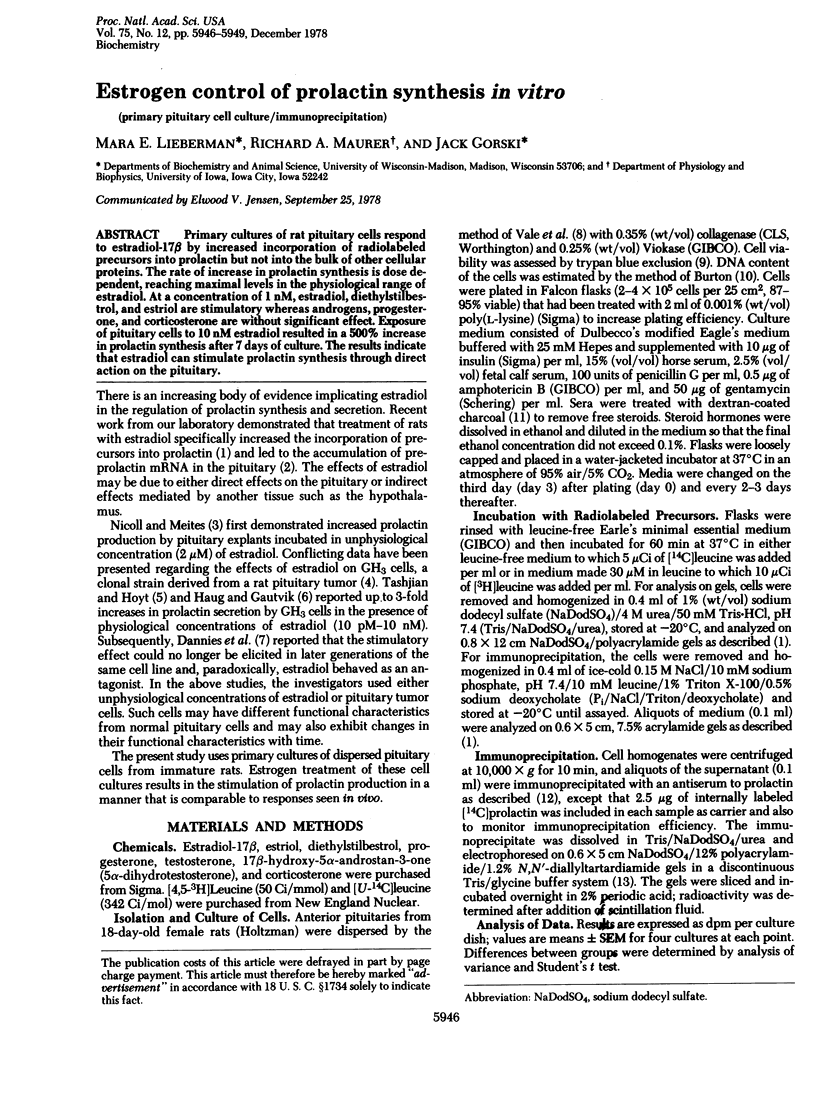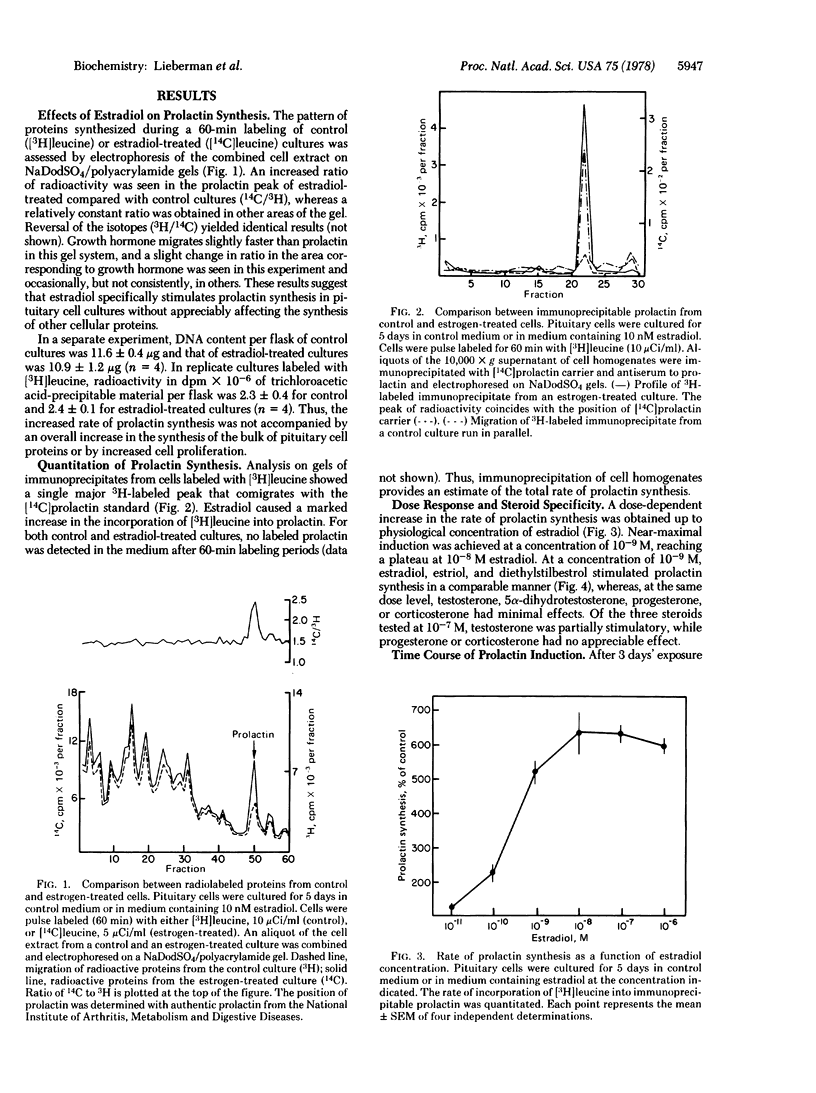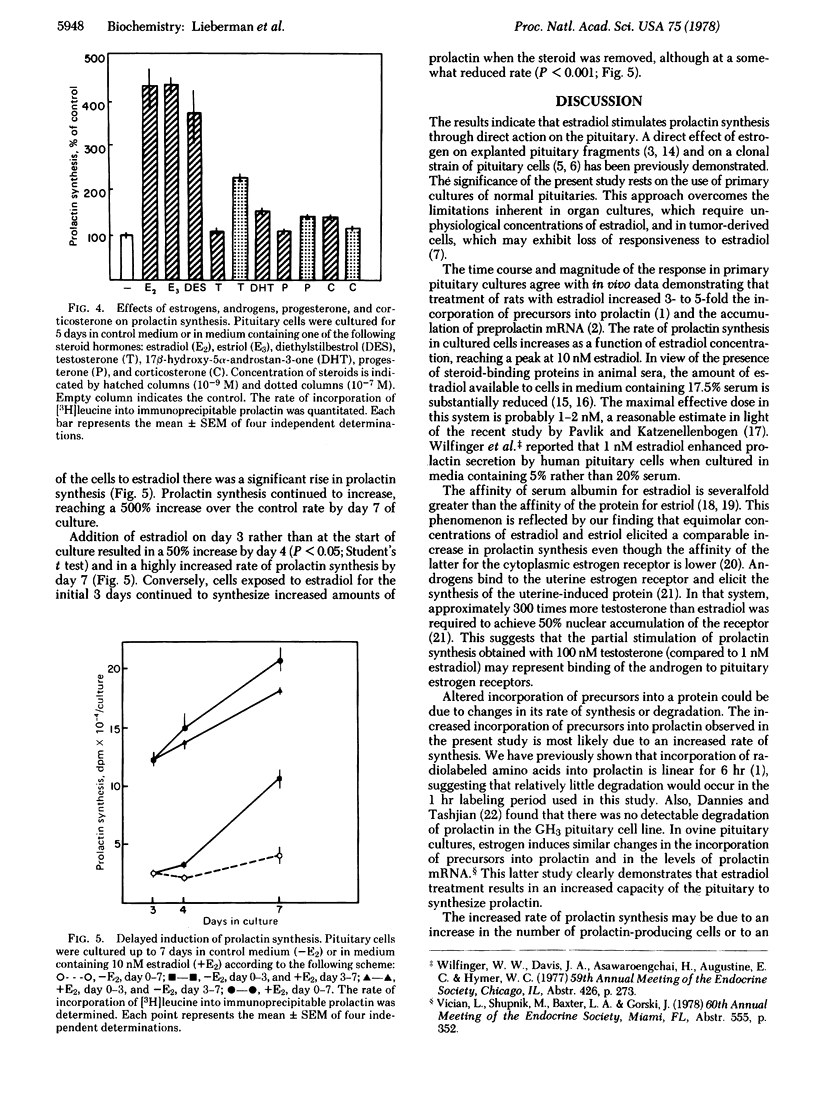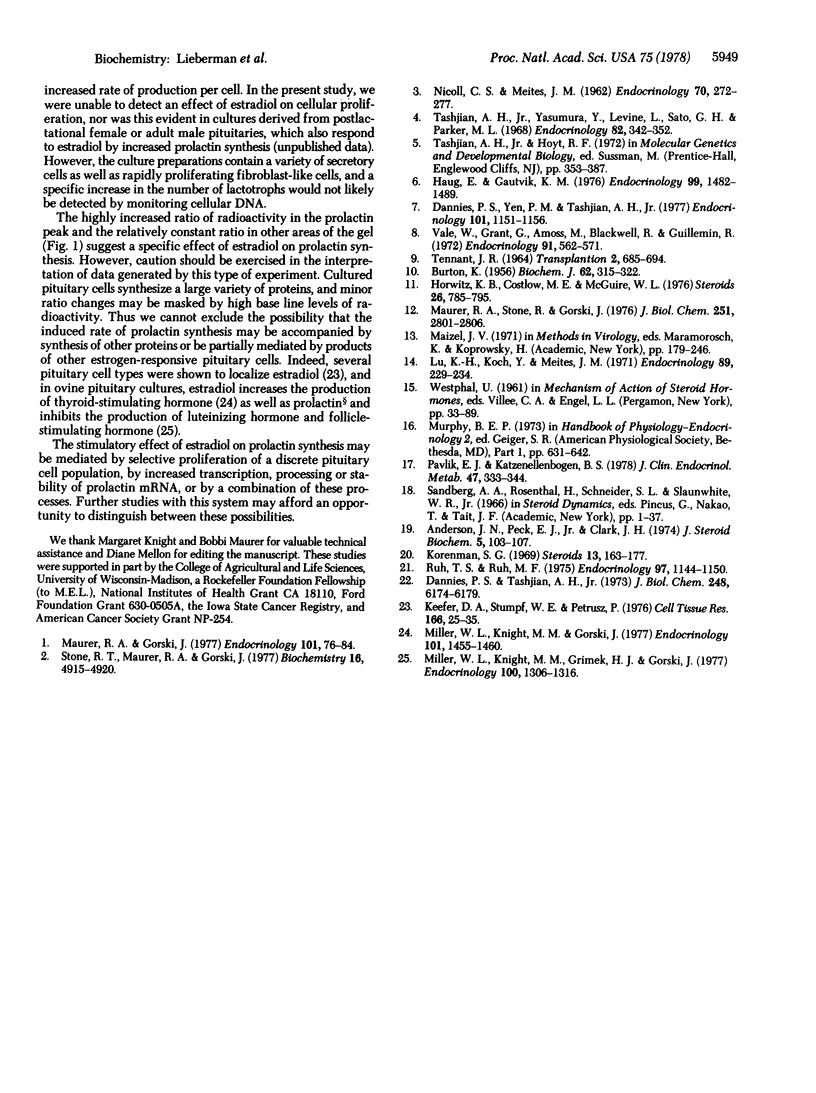Abstract
Primary cultures of rat pituitary cells respond to estradiol-17beta by increased incorporation of radiolabeled precursors into prolactin but not into the bulk of other cellular proteins. The rate of increase in prolactin synthesis is dose dependent, reaching maximal levels in the physiological range of estradiol. At a concentration of 1 nM, estradiol, diethylstilbestrol, and estriol are stimulatory whereas androgens, progesterone, and corticosterone are without significant effect. Exposure of pituitary cells to 10 nM estradiol resulted in a 500% increase in prolactin synthesis after 7 days of culture. The results indicate that estradiol can stimulate prolactin synthesis through direct action on the pituitary.
Full text
PDF



Selected References
These references are in PubMed. This may not be the complete list of references from this article.
- Anderson J. N., Peck E. J., Jr, Clark J. H. Nuclear receptor-estrogen complex: in vivo and in vitro binding of estradiol and estriol as influenced by serum albumin. J Steroid Biochem. 1974 Apr;5(2):103–107. doi: 10.1016/0022-4731(74)90114-9. [DOI] [PubMed] [Google Scholar]
- BURTON K. A study of the conditions and mechanism of the diphenylamine reaction for the colorimetric estimation of deoxyribonucleic acid. Biochem J. 1956 Feb;62(2):315–323. doi: 10.1042/bj0620315. [DOI] [PMC free article] [PubMed] [Google Scholar]
- Dannies P. S., Tashjian A. R., Jr Effects of thyrotropin-releasing hormone and hydrocortisone on synthesis and degradation of prolactin in a rat pituitary cell strain. J Biol Chem. 1973 Sep 10;248(17):6174–6179. [PubMed] [Google Scholar]
- Dannies P. S., Yen P. M., Tashijian A. H., Jr Anti-estrogenic compounds increase prolactin and growth hormone synthesis in clonal strains of rat pituitary cells. Endocrinology. 1977 Oct;101(4):1151–1156. doi: 10.1210/endo-101-4-1151. [DOI] [PubMed] [Google Scholar]
- Haug E., Gautvik K. M. Effects of sex steroids on prolactin secreting rat pituitary cells in culture. Endocrinology. 1976 Dec;99(6):1482–1489. doi: 10.1210/endo-99-6-1482. [DOI] [PubMed] [Google Scholar]
- Horwitz K. B., Costlow M. E., McGuire W. L. MCF-7; a human breast cancer cell line with estrogen, androgen, progesterone, and glucocorticoid receptors. Steroids. 1975 Dec;26(6):785–795. doi: 10.1016/0039-128x(75)90110-5. [DOI] [PubMed] [Google Scholar]
- Keefer D. A., Stumpf W. E., Petrusz P. Quantitative autoradiographic assessment of 3H-estradiol uptake in immunocytochemically characterized pituitary cells. Cell Tissue Res. 1976 Feb 6;166(1):25–35. doi: 10.1007/BF00215122. [DOI] [PubMed] [Google Scholar]
- Korenman S. G. Comparative binding affinity of estrogens and its relation to estrogenic potency. Steroids. 1969 Feb;13(2):163–177. doi: 10.1016/0039-128x(69)90004-x. [DOI] [PubMed] [Google Scholar]
- Lu K. H., Koch Y., Meites J. Direct inhibition by ergocornine of pituitary prolactin release. Endocrinology. 1971 Jul;89(1):229–233. doi: 10.1210/endo-89-1-229. [DOI] [PubMed] [Google Scholar]
- Maurer R. A., Gorski J. Effects of estradiol-17beta and pimozide on prolactin synthesis in male and female rats. Endocrinology. 1977 Jul;101(1):76–84. doi: 10.1210/endo-101-1-76. [DOI] [PubMed] [Google Scholar]
- Maurer R. A., Stone R., Gorski J. Cell-free synthesis of a large translation product of prolactin messenger RNA. J Biol Chem. 1976 May 10;251(9):2801–2807. [PubMed] [Google Scholar]
- Miller W. L., Knight M. M., Gorski J. Estrogen action in vitro: regulation of thyroid stimulating and other pituitary hormones in cell cultures. Endocrinology. 1977 Nov;101(5):1455–1460. doi: 10.1210/endo-101-5-1455. [DOI] [PubMed] [Google Scholar]
- Miller W. L., Knight M. M., Grimek H. J., Gorski J. Estrogen regulation of follicle stimulating hormone in cell cultures of sheep pituitaries. Endocrinology. 1977 May;100(5):1306–1316. doi: 10.1210/endo-100-5-1306. [DOI] [PubMed] [Google Scholar]
- NICOLL C. S., MEITES J. Estrogen stimulation of prolactin production by rat adenohypophysis in vitro. Endocrinology. 1962 Feb;70:272–277. doi: 10.1210/endo-70-2-272. [DOI] [PubMed] [Google Scholar]
- Pavlik E. J., Katzenellenbogen B. S. Human endometrial cells in primary tissue culture: estrogen interactions and modulation of cell proliferation. J Clin Endocrinol Metab. 1978 Aug;47(2):333–344. doi: 10.1210/jcem-47-2-333. [DOI] [PubMed] [Google Scholar]
- Ruh T. S., Ruh M. F. Androgen induction of a specific uterine protein. Endocrinology. 1975 Nov;97(5):1144–1150. doi: 10.1210/endo-97-5-1144. [DOI] [PubMed] [Google Scholar]
- Stone R. T., Maurer R. A., Gorski J. Effect of estradiol-17 beta on preprolactin messenger ribonucleic acid activity in the rat pituitary gland. Biochemistry. 1977 Nov 1;16(22):4915–4921. doi: 10.1021/bi00641a027. [DOI] [PubMed] [Google Scholar]
- TENNANT J. R. EVALUATION OF THE TRYPAN BLUE TECHNIQUE FOR DETERMINATION OF CELL VIABILITY. Transplantation. 1964 Nov;2:685–694. doi: 10.1097/00007890-196411000-00001. [DOI] [PubMed] [Google Scholar]
- Tashjian A. H., Jr, Yasumura Y., Levine L., Sato G. H., Parker M. L. Establishment of clonal strains of rat pituitary tumor cells that secrete growth hormone. Endocrinology. 1968 Feb;82(2):342–352. doi: 10.1210/endo-82-2-342. [DOI] [PubMed] [Google Scholar]
- Vale W., Grant G., Amoss M., Blackwell R., Guillemin R. Culture of enzymatically dispersed pituitary cells: functional validation of a method. Endocrinology. 1972 Aug;91(2):562–572. doi: 10.1210/endo-91-2-562. [DOI] [PubMed] [Google Scholar]


